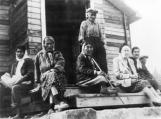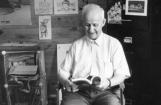1
CONTENTS:- The First Missionaries
- Later Missionaries
- Residential Schools
2
The First MissionariesIn early 1900s, Anglican missionaries came to settle at Little Salmon Village. Rev. Cecil Swanson opened St. Peter's Mission there in 1914, and it styaed open until 1928. In 1915, he built St. Luke's (called St. George's after 1921) at Carmacks.
The Northern Tutchone people's traditional culture was soon affected by the new way of life. The church condemned many parts of people's traditional culture. For example, people stopped cremating the dead at this point, and began burying them instead. Anglican Rev. John Hawksley (also the first Indian Agent) made an effort to ban potlatches as well.
3
Little Salmon Anglican Mission1915
Tanintse Chu Dachäk (Little Salmon Village)
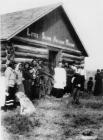 Credits:
Credits:(PHO 383 89/41 #1970)
4
Carmacks Anglican MissionDate not available
Carmacks, Yukon
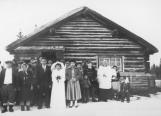 Credits:
Credits:(Yukon Archives PHO 381 89/41 #1553)
6
Later MissionariesOver time, many First Nations people incorporated Christian beliefs into their lives, and blended them together with the teachings of the Hudé Hudän.
The Anglican Church maintained a sporadic presence in Carmacks for many decades. The Catholic Church also had some presence in later years. Father Jean Paul Tangauy ministered in Carmacks from the mid-1950s to the late 1960s. He was extremely popular with the First Nation people, hosting social dances on weekends. He is remembered fondly, and spoken of often. He also left a valuable photographic record, much of which appears in this exhibit.
7
Father Jean Paul Tanguay inside Catholic Church1953
Carmacks, Yukon
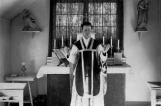 Credits:
Credits:(Yukon Archives PHO 372 88/150 #10B)
9
Choutla Residential School and First Nation studentsJune, 1921
Carcross, Yukon
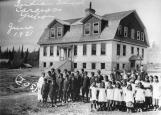 Credits:
Credits:(Yukon Archives PHO 91 78/67 #49)
10
Residential SchoolsMissionaries hoped to teach First Nation children European religion, skills, and culture. In Carmacks, the St. Luke's mission provided a day school that was taught by Reverend Swanson.
However, some of the native First Nation children were sent to residential schools far away from their home. Yukon children were either to Choutla School (Anglican) at Carcross or to Lower Post School (Catholic) in British Columbia. The children would stay for the whole year, and return home in the summer. After, a couple of months they were sent back to their school.
In 1944, Canada introduced the Family Allowance Act to provide assistance to parents. However, payment required that children attend school, which added pressure on people to send their children away to residential school.
The effects of the residential schools could not have been more devastating. Children were forbidden to speak their language, and taught only European culture. When they returned home in the summer, they had trouble relating to their families. When they finally finished school, they hadn't learned any of the skills and beliefs that had sustained their people for thousands of years. The residential schools were like cutting a link out of a chain, and the effects are still being felt today.
In the late 1950's, the public schools were opened to First Nations people. The missionaries soon closed their residential schools and people started going to the Carmacks school instead.
In the early 1960's, some children styed at Yukon Hall in Whitehorse when attending school. During the holidays they were sent home to be with their families. Sometime in the early 1980's Yukon Hall was closed down.
11
Carmacks students at Lower Post Residential SchoolDate not available
Lower Post, British Columbia
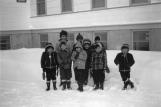 Credits:
Credits:(Yukon Archives PHO 372 88/150 #34)
